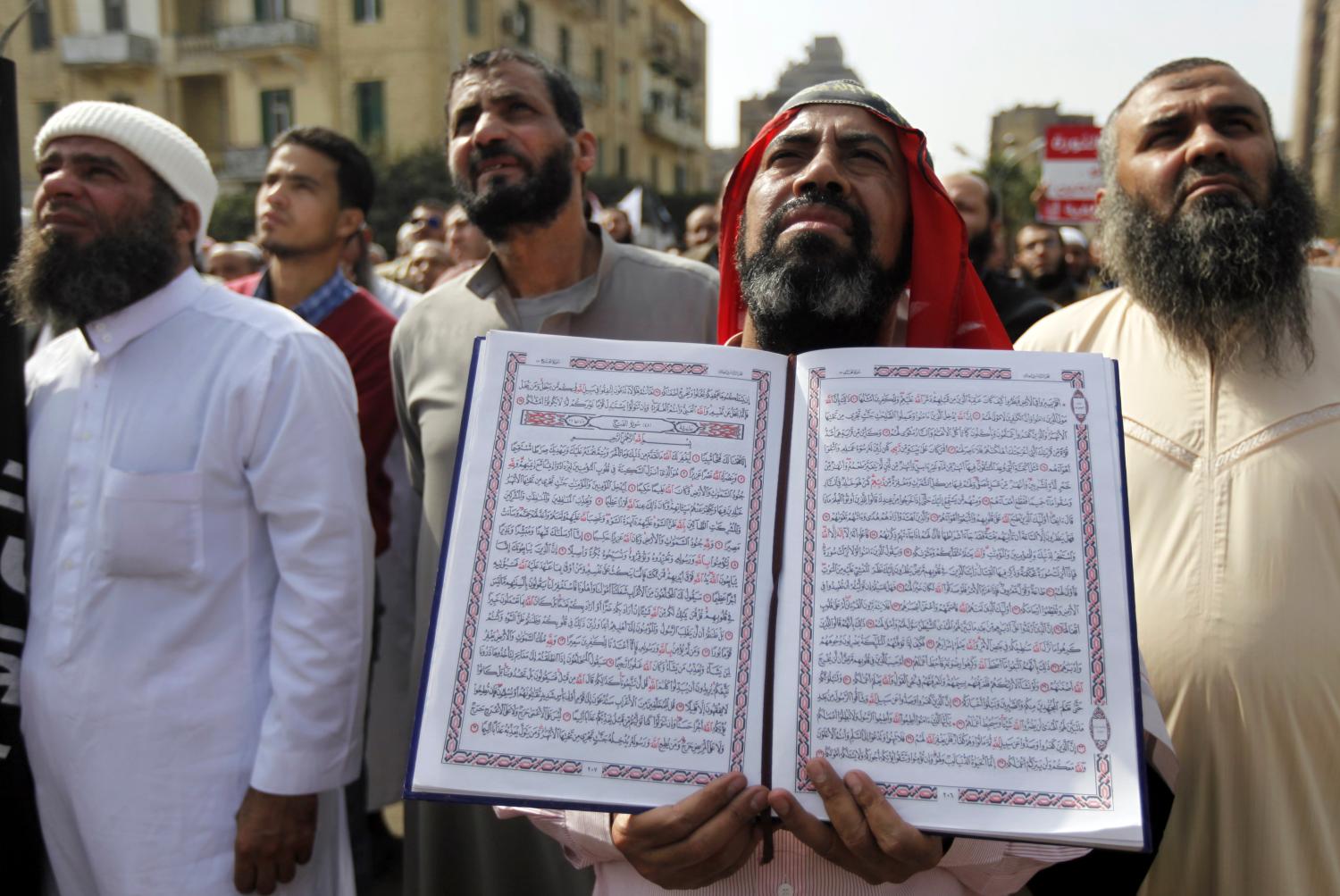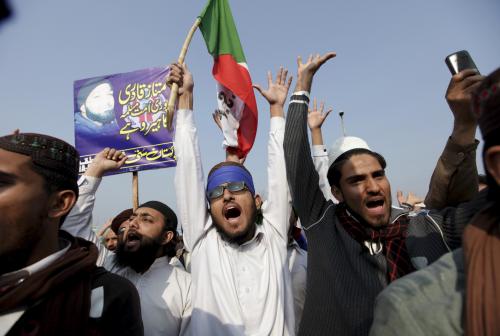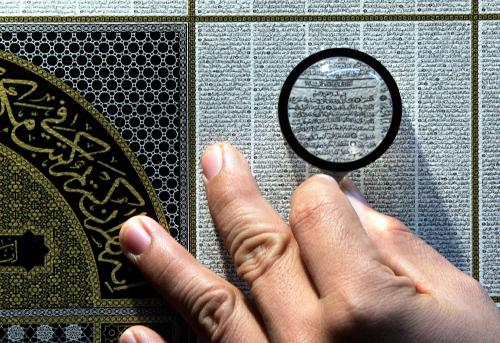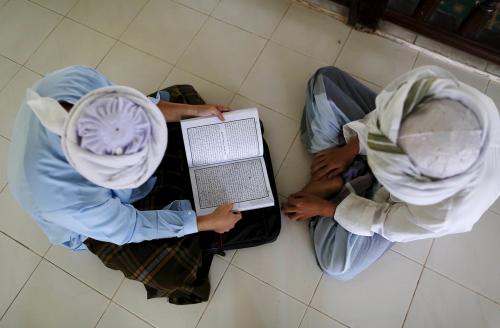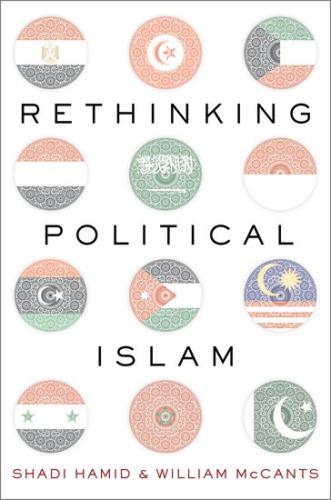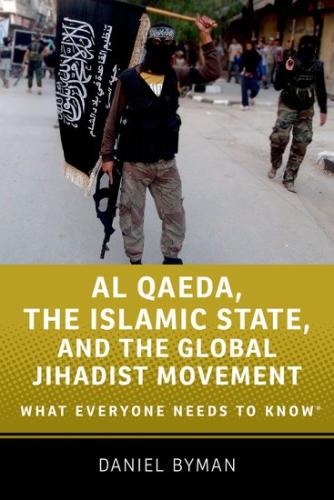Editor’s Note: As part of Brookings’s Rethinking Political Islam project, we’ve asked a select group of outside scholars to react and respond to the overall project, in order to draw attention to potential blind spots, trends of note, and more. First off is the scholar of Salafism Jacob Olidort, followed by a response from Raphaël Lefèvre, whose research focuses on the Syrian Muslim Brotherhood.
Given the changes in identities, doctrines, and actions of Islamist groups vying in the tumultuous past six years, Brookings’ “Rethinking Political Islam” initiative is a critical opening for a new conversation on how we—in academic, policy, and public debates—think about those Islamist groups we consider to be politically-relevant. The eleven working papers all underscore the common tension between the ideological principles of these organizations and the alliances they have made, some of which go against these very principles. To those who consider the long view of modern Middle East history, these tensions come as no surprise, given that these are all movements whose founding doctrines and early development during the 20th century were just as much determined by political pressures and personal interests.
While personality and generational differences have historically been factors in how and whether groups survive in shifting political environments, the pressures and stakes changed dramatically after the 2011 uprisings, when many Islamists were able to test their principles in positions of power and when the significance of their actions were amplified across the region through social media channels. As the papers of Monica Marks and Raphaël Lefèvre show, the missteps of the region’s oldest Islamist group, the Egyptian Muslim Brotherhood, had the effect of alienating it from other Islamist groups in the region.[1]
The impact of the Egyptian Muslim Brotherhood’s actions on the self-perceptions and maneuvers of Islamists elsewhere are one example of the ways in which local actions can have new kinds of transregional impact. However, even where this impact is felt, these papers remind us of the need to tread carefully when describing how these groups relate to and influence one another in their ambitions and priorities. Here Joseph Liow provides a helpful reminder in the case of Southeast Asia and the connections between local groups and their counterparts in the Middle East. He argues that it was through the organizational efforts of both student groups, such as the Himpunan Mahasiswa Islam in Indonesia and Angkatan Belia Islam Malaysia, and through coordinated humanitarian efforts on behalf of regional political causes, that Islamists were able to build transnational connections.[2]
Liow’s discussion of the role of humanitarian campaigns and student organizations in forging transnational bonds raises some of the key questions we face when trying to understand the formation of new “imagined communities” of Islamists both across and beyond the Middle East, as well as within particular countries. Namely, do the members of local Islamist groups build transregional links because they identify with a common Islamist ideology or shared communal experiences of living under authoritarian states (as, for example, Marks shows with Tunisian Nahdawis recalling their treatment under Ben Ali when looking at Sissi), or perhaps it is because the sectarian nature of certain conflicts, or still professional and personal ties?
Ironically, the nature of these connections has become more confused with the greater visibility we now have with social media platforms. Likewise, changes at home can be caused by foreign policy decisions, and the reverse. Here Toby Matthiesen shows how local Saudi support for the king ebbed and flowed not because of domestic issues but rather because of perceptions of the king in relation to major foreign policy developments, especially the country’s backing of Sissi’s government in Egypt and its response to heightened Iranian influence in the region.[3] Similarly, David Patel reminds us concerning Islamists in Jordan that “[t]he difference between so-called ‘hawks’ and ‘doves’ has more to do with disagreements about how accommodationist the Islamic movement should be with the Jordanian government than it does with ideological differences.”[4] In other words, the local and the regional environment can be equally, if not more, determinant of Islamist politics than ideological principles. Indeed, with the increased sectarian dimension of many Middle East conflicts, it is these external factors that help define the narratives and ideological priorities of Islamist groups and influence their political alignments.
This raises another important issue of locating influence and impact of these groups. Much like the caution with which we describe relationships between Islamist movements, so too is it especially important to rethink the assumptions of where their political influence actually comes from. Here Matthew Nelson’s paper on Islamist parties that wield considerable influence in Pakistan despite their poor electoral performance is a trend increasingly on display in the Middle East, particularly given voters’ low confidence (and interest) in formal political processes.[5] This general political apathy may mean that, in contrast to the early days of the Arab uprisings when Islamists found opportunity within formal political institutions, perhaps Islamists don’t feel they need to rely on these spaces to claim influence. And it is perhaps for this reason that ultraconservative groups, who for decades explicitly eschewed formal politics, who today are more capable of maneuvering within political spaces that are either fluid or failed. Thus, much like Nelson’s argument concerning Pakistan’s Islamist groups, the poor performance of the Salafi Nour party, which won only 12 seats in the 2015 elections, should in no way be misconstrued as a commentary on the weak influence of Islamic politics in Egypt. Rather, to locate the dynamics of Islamic politics in Egypt, as in other countries, we now need to look elsewhere—in particular to social media platforms, publications, mosques and the various public spaces throughout Egypt—to witness where real political influence is being negotiated.
Curiously, the papers generally don’t highlight the most important change that took place—that all of these movements were products of a late-twentieth century political space characterized by a stable, or at the very least predictable, political infrastructure and culture. By the time these groups had politically matured, they found themselves operating within semi-authoritarian states whose accommodation (or, more often, lack thereof) of Islamist participation was relatively easy to assess. And that it was in response to such predictable and stable political spaces that these Islamist groups formed their identities. Today, by contrast, in nearly every country surveyed the local government has a mere façade of stability, at best, and rather little about its policies that can be described as predictable. This adds a measure of uncertainty for the Islamists operating within those borders – indeed, just as we are trying to rethink Islamism, so too are Islamists rethinking their political Islam in relation to uncertain local and regional settings.
Aside from the stability of local governments, the other major difference from the political situation is that political culture is increasingly being defined and arbitrated in sectarian terms – a point that, interestingly, only one paper discusses in any significant way. Even though the main theater of sectarian tensions is in Iraq, Syria and Yemen, and while at the state level only Saudi Arabia and Iran have officially embraced the themes that would make it relevant, it is the sectarian significance of these conflicts that reverberates across borders and could determine, for example, the “mouvance” (to use Monica Marks’s term) of Salafi-jihadis in places like Tunisia. More discussion of this new sectarian flavor in regional politics would provide added insight into the regional rise of voices, such as those of the Salafis, precisely because it is they who have created the political language for reading significance into sectarian tensions.
Third is the question of social media, which earned no significant treatment in these studies. While it is certainly easy to overstate the importance of social media, there are significant analytical risks of understating it. After all, it is through social media that the sectarian portrayal of regional conflict is promoted, and it is through social media that new transregional links are created in ways that hadn’t existed prior to 2011. Therefore, not considering the role, if not the responsibility, of social media in some of these large-scale shifts risks mischaracterizing the dynamics of Islamist groups as merely local phenomena (and they may, in some cases, be just that).
Finally, in terms of categories and terms, we too often remain married to pre-2011 typologies. Here Marks’s observation regarding “the tendency, in both local and Western press, to label religiously oriented actors as diverse as Salafi jihadis, Boko Haram, the Egyptian Brotherhood, and Ennahda as ‘Islamists’ [having] generated additional confusion regarding Ennahda’s identity and aims” is just as relevant beyond the case of Ennahda, and for which my own work tries to provide some granularity.[6] When looking at the Kuwaiti case, for example, even the line between “Muslim Brotherhood” and “activist Salafi” has been blurred. It is precisely when these groups are rethinking their founding doctrines within fluid political settings that the academic and policy communities would do well to revisit the fundamental differences between these groups (for example, the legal-theological Salafi orientation versus the modern political ideology of the Brotherhood) as entry points for understanding them. Specifically, it is the very distinctions between the priorities of Salafis and Brotherhood-inspired organizations—the former aiming to ensure that only their understanding of Islamic ritual and creed dominates, while the latter that Islam in general be in a position of social and political influence—that provides the key to understanding the different approaches to popular mobilization each uses and why the former may resonate more today.
Indeed, given the scale of all of these political shifts, and the blurring of lines between groups, how precisely can we tell “extremist” from “non-extremists?” and what does it mean to be “radical” (i.e. radical in relation to what?) versus “moderate?” Certainly, ISIS is unique in its grotesque brutality, which has even alienated the organization from even other jihadi groups, and can therefore be treated as an isolated phenomenon. But when comparing the objectives and nature of the many other groups, from the AQ-affiliated jihadis to the Syrian militants to the non-violent Salafis, might we as scholars not do well to provide to readers some deeper and more descriptive vocabulary for distinguishing these myriad groups at a time when so much is at stake? Moreover, there is an added epistemological risk of using the terms like “extremist” and “moderate” to distinguish, for example, between the various opposition groups; we need to remember that local voices (Assad, for example) use these same terms to push their own very different, and often destructive, interests and agendas.
Here it is surprising to see some of the papers promote the “inclusion-moderation hypothesis” as applied to the Muslim Brotherhood, especially given that we now know of the opaque nature of the causes and contexts in which they have evolved over the last six years. Here Courtney Freer offers the helpful reminder that “Islamists do not necessarily moderate when included in a political system, nor do they always privilege ideological policies over systemic political change more broadly.”[7]
It seems that given the transformative nature of these large-scale political changes, these circumstances must be somehow integrated into our new thinking about political Islam, and specifically towards understanding various Islamic groups within the political sphere as dynamic and relational to their political environments. Here I disagree somewhat with Raphaël Lefèvre’s argument that we need “a renewed focus on the kind of internal dynamics which take place within Islamist groups [that] may shed light on the factors accounting for their resilience.” He argues for adopting resource mobilization theory in which Islamist groups are studied according to their “organizational survival” and suggests looking at the internal bureaucracy that provides political and professional opportunities to those who commit to a group’s cause. This may be the case, but I wonder about the relevance of using these bureaucratic relationships as an analytical prism at a time when Islamist groups’ political context is not always bureaucratic, much less local, and, when the increasing fragility of states does not always accommodate the functions of organized bureaucracies. Rather, with the globalization of the political sphere and the greater contact between various Islamist groups, it may be more productive to understand them in relation to those broader circumstances. Specifically, borrowing from a typology I used to describe the different kinds of sectarianisms in the Middle East, we could better understand Islamist groups today in functional terms as they carve out spaces for themselves within these new settings—(institutional) whether and to what degree they directly engage local political institutions; (exploitative) whether they embrace violent mechanisms to exploit local instability, or; (accommodationist) in which they engage with politically-relevant themes without challenging existing institutions or directly becoming involved in formal politics.[8]
The Brookings Institution’s Rethinking Political Islam project has offered welcome room for debate on the shifting dynamics shaping Muslim Brotherhood groups in a new Middle East. Jacob Olidort’s [9] recent contribution is particularly useful in two respects. First, he highlighted some of the contemporary issues affecting the Brotherhood which scholars have not sufficiently examined, such as the role of social media and simmering sectarian tensions. Second, and most importantly, he steps into the theoretical debate about Islamic mobilization to argue that researchers must rethink certain assumptions in light of what we know now. In his view, today’s Islamist movements are the “products” of their immediate political environment—in other words, to understand the decisions made by the Egyptian Muslim Brotherhood, one needs to look primarily at the “external circumstances” surrounding it, such as the Egyptian regime’s crackdown on the movement since 2013. He worries that scholars, in formulating their analyses, have not sufficiently taken into account the sheer scale of political change which the region has witnessed since the Arab Spring.
That context deeply matters and impacts political—and, in our case, Islamist—mobilization, was actually a central theme of earlier Rethinking Political Islam essays and is, more broadly, a well-established argument in the theoretical literature. But there are major issues with viewing this approach as the primary factor explaining the “ideological priorities” and “political alignment” of Islamist groups. Indeed, it implicitly denies them agency and autonomy from their immediate political environment while effectively sidelining complementary theoretical perspectives. What instead appears timely, in a Middle Eastern context marked by repression, civil wars, and state collapse is to look at how national and regional politics impact internal dynamics within these groups. Movements affiliated with the Muslim Brotherhood are characterized by a complex decision-making process, thus making their very strategies and ideological platforms the result of virulent debates and internal power struggles. These are sophisticated organizations and informal bureaucracies with an agency of their own.
The Brotherhood as a “bureaucracy”
Considering Muslim Brotherhood movements as “bureaucracies” may at first glance seem out of tune with prevailing perceptions of the current state of the Middle East. Jacob Olidort thus wonders about the relevance of this approach “at a time when their political context is not always bureaucratic, much less local and when the increasing fragility of states does not always accommodate the functions of organized bureaucracies.” In reality, however, there is no necessary contradiction between these groups’ organizational sophistication and the unstable political context around them. First, viewing the Muslim Brotherhood as an informal bureaucracy does not imply that it functions like a Weberian-style centralized and hierarchical public administration. It merely refers to the organization’s seemingly unique capacity, in the Islamist field, to develop its own decision-making model and mobilize resources and staff to achieve its ends. This perspective on the Brotherhood is not in contradiction with others—in fact, it seeks to offer a more complete picture of the movement by going beyond discourse analysis in order to understand the complex web of factors that shape its decisions on crucial issues.
Second, the currently dire situation faced by Muslim Brotherhood branches in Syria and Egypt, both in exile due to the considerable repression they face at home, does not diminish the relevance of such an approach—if anything, it heightens it. This may seem counterintuitive. Yet my research into the evolution of the Syrian Muslim Brotherhood’s networks since 1982 (when it was forced out of the country) suggests that as Islamist groups go into exile, their priority shifts to organizational survival—and bureaucracy is the only tool they are left with. They use it to continue thriving abroad by developing a professional cadre of members, socializing sympathizers into party loyalty, mobilizing resources to create social and political opportunities for members, and protecting themselves against major splits. In fact, the Brotherhood’s ability to use its bureaucratic structures and networks is what has allowed it, in the Syrian case and, I suspect, in the Tunisian and Libyan cases too, to survive against the odds for decades in exile before making surprisingly successful comebacks. They may have lost ground since 2012 but their resilience owes much to their organization.
Setting a new research agenda
While this institutionalist approach points to the Muslim Brotherhood’s strengths, it also highlights some of the group’s weaknesses. As a social movement grows older and gains in organizational sophistication, its structures are likely to become more “oligarchized.” Members, who often depend on its bureaucracy for social and professional reasons, may become guided more by a desire to preserve the organization than to achieve its stated goals. This has two negative implications for the Muslim Brotherhood which may help explain the lack of popularity it sometimes faces even in the more pious subsections of society. First, the fact that the Brotherhood might be guided by an instinct for organizational maintenance might lead it to make decisions that contradict with its ideological message. This heightens popular mistrust of the organization’s “real” agenda and paves the way for the often more uncompromising Salafis to challenge its authenticity and religious legitimacy. Second, the Brotherhood’s “oligarchization” means the emergence of clique structures within the organization that can lead to the concentration of power in the hands of just a select few. The group’s branches from Syria to Egypt and Jordan are all directed by figures who have been in control for decades—they are “career Muslim Brothers” and their continued monopoly on power is harming the groups’ outside image and leading to generational splits.
This institutionalist approach to the Muslim Brotherhood draws on the conceptual tools developed by sociologists Roberta Ash [10], John Mc Carthy and Mayer Zald [11] in relation to their work on “resource mobilization theory” in the context of “social movement organizations.” Their theoretical insights are rich, and they offer avenues for the type of multidisciplinary research into the Brotherhood that the literature on Islamist groups is sometimes still lacking. They point to the need of studying these movements’ extensive networks, organizational structures, decision-making arrangements, as well as internal politico-ideological debates. Yet they also demonstrate the importance in times of political uncertainty focusing greater attention on the nature and degree of tensions between the base and leadership and older and younger generations. These internal dynamics weigh more heavily than we might expect on Islamist groups’ political and ideological choices and, thus, need to be examined more carefully. Being equipped with some of the conceptual tools mentioned above and with by the theoretical insights of political science, sociology and even anthropology and ethnography, can help us address these under-studied yet crucial themes at a critical point in time.
[1] Monica Marks, “Tunisia’s Ennahda: Rethinking Islamism in the context of ISIS and the Egyptian coup,” Brookings Institution, August 2015. https://www.brookings.edu/~/media/Research/Files/Reports/2015/07/rethinking-political-islam/Tunisia_Marks-FINALE.pdf?la=en; Raphaël Lefèvre, “Islamism within a civil war: The Syrian Muslim Brotherhood’s struggle for survival,” Brookings Institution, August 2015. https://www.brookings.edu/research/reports2/2015/08//sitecore/shell/~/media/Research/Files/
Reports/2015/07/rethinking-political-islam/Final-Working-Papers/Syria_Lefevre_FINALv.pdf
[2] Joseph Liow, “The Arab Spring and Islamist activism in Southeast Asia: Much ado about nothing?,” Brookings Institution, August 2015. https://www.brookings.edu/research/reports2/2015/08//sitecore/shell/~/media/Research/Files/
Reports/2015/07/rethinking-political-islam/Final-Working-Papers/Southeast-Asia_Liow_FINALv.pdf
[3] Toby Matthiesen, “The domestic sources of Saudi foreign policy: Islamists and the state in the wake of the Arab Uprisings,” Brookings Institution, August 2015. https://www.brookings.edu/research/reports2/2015/08//sitecore/shell/~/media/Research/Files/
Reports/2015/07/rethinking-political-islam/Saudi-Arabia_Matthiesen_FINALFINALFINAL.pdf
[4] David Patel, “The more things change, the more they stay the same: Jordanian Islamist responses in spring and fall,” Brookings Institution, August 2015. https://www.brookings.edu/research/reports2/2015/08//sitecore/shell/~/media/Research/Files/
Reports/2015/07/rethinking-political-islam/Final-Working-Papers/Jordan_Patel_FINALv.pdf
[5] Matthew Nelson, “Islamist politics in South Asia after the Arab Spring: Parties and their proxies working with—and against—the state,” Brookings Institution, August 2015. https://www.brookings.edu/research/reports2/2015/08//sitecore/shell/~/media/Research/Files/
Reports/2015/07/rethinking-political-islam/Final-Working-Papers/Pakistan_Nelson_FINALv.pdf
[6] Jacob Olidort, “Fall of the Brotherhood, Rise of the Salafis,” Lawfare Institute, 11 October 2015. https://www.lawfareblog.com/fall-brotherhood-rise-salafis
[7] Courtney Freer, “The rise of pragmatic Islamism in Kuwait’s post-Arab Spring opposition movement,” Brookings Institution, August 2015. https://www.brookings.edu/research/reports2/2015/08//sitecore/shell/~/media/Research/Files/
Reports/2015/07/rethinking-political-islam/Final-Working-Papers/Kuwait_Freer_FINALv.pdf
[8] Jacob Olidort, “The truth about sectarianism: behind the various strands of Shiite-Sunni discord,” Foreign Affairs, 25 January 2016. https://www.foreignaffairs.com/articles/middle-east/2016-01-25/truth-about-sectarianism
[9] Jacob Olidort, “Rethinking how we rethink political Islam,” Brookings Institution, March 2016.
[10] Mayer N. Zald and Roberta Ash, “Social movement organizations: growth, decay and change” in Social Forces (Vol.44, No.3, 1966)
[11] John D. McCarthy and Mayer N. Zald, “Resource mobilization and social movements: a partial theory” in American Journal of Sociology (Vol.82, No.6, 1977)
